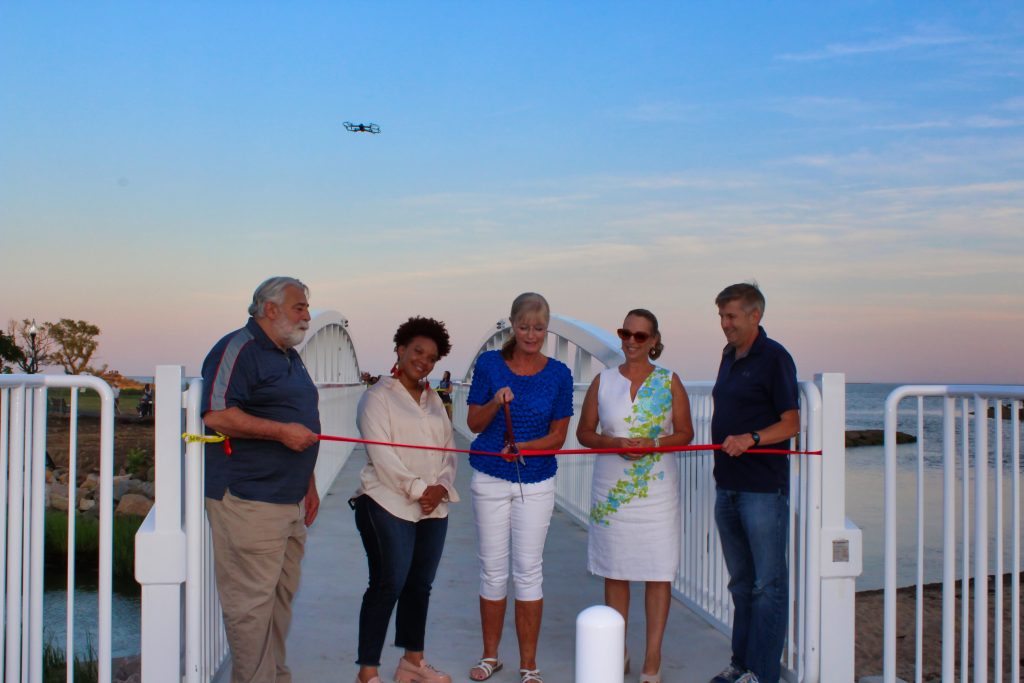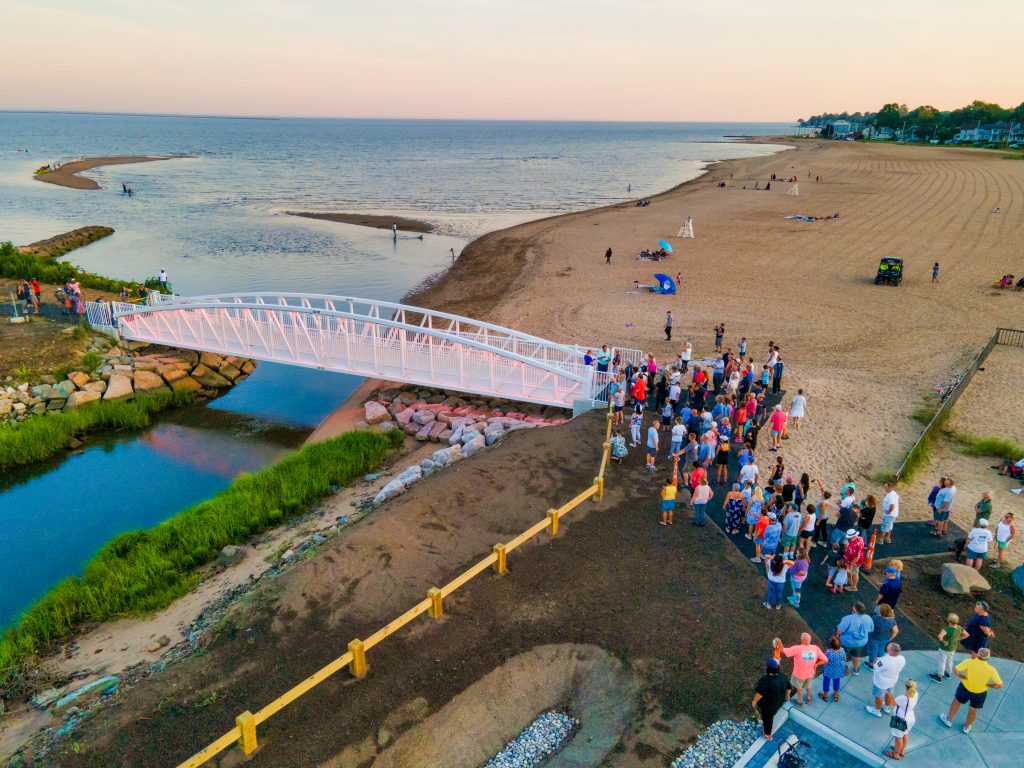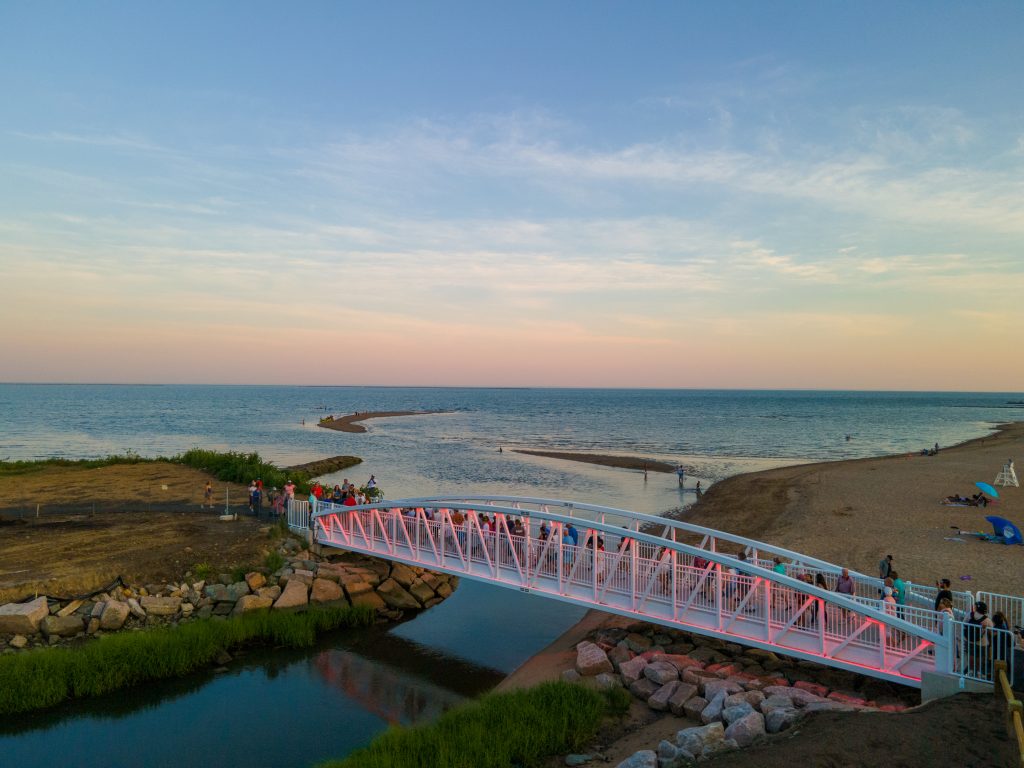

By Michael P. Walsh
Special to the Voice
With a vibrant crowd looking on, Mayor Nancy R. Rossi and state Rep. Dorinda Borer, D-West Haven, cut a red ribbon to “light the bridge” to mark the official opening of the new Cove River pedestrian bridge in West Shore on July 19.
Standing at the bridge’s Sea Bluff Beach entrance with members of the city’s General Assembly delegation, Borer and Rossi, sporting a pair of oversize scissors, led the gathering of more than 250 people in an enthusiastic countdown before cutting the ribbon and setting the bridge aglow.
The all-ages crowd oohed and aahed at the newly lit bridge, bedecked with LED lights illuminated in red and white — and even purple, Rossi’s favorite color.
The Navels, a local classic rock band, also got in on the celebration, playing a free concert before and after the lighting spectacle in Sea Bluff Beach’s new upper parking lot, just a stone’s throw from the bridge off Captain Thomas Boulevard.
“This is a beautiful addition to our city, and for the first time in over 20 years, pedestrians will be able to cross over Cove River,” Rossi told the crowd, moments before lighting the bridge.
She added: “We are here this evening not just to celebrate the official opening of the bridge but also to view its beautiful light display. The LED lights are capable of the full spectrum of colors, allowing for unique displays. This will be an amazing addition to our scenic shoreline!”

Rossi concluded her remarks by thanking Borer for obtaining the project funding and the rest of West Haven’s state delegation for their support. She also thanked City Engineer Abdul Quadir and a list of project contractors.
The pedestrian bridge features decorative lighting designed by Apex Lighting Solutions of Wethersfield, according to the project manager, Keith Lundgrin of Terry Contracting & Materials Inc. of Riverhead, New York.
Lundgrin said the LED lighting, mounted on the arch and controlled by a phone app, is programmed to change colors and display color patterns and sequences on the bridge for holidays.
The 88-foot-long, prefabricated aluminum truss bridge connects Bradley Point Park to Sea Bluff Beach. Manufactured by GatorBridge of Sanford, Florida, the white powder-coated bridge replaces the original concrete footbridge built in 1938.
The Frankson Fence Co. of North Haven fabricated and installed a matching guardrail at each end of the bridge.
The Sea Bluff parking lot, though not completely finished, has been “significantly” upgraded with gray, permeable brick pavers that allow water to penetrate the joints and drain into the gravel base with no runoff, Lundgrin said.
The lot will also include new Victorian lampposts, along with fresh plantings this fall, he said.
The bridge complements the new Cove River tide gate system, which became operational in late 2021.
The pedestrian bridge and tide gate project, which began in March 2021, is part of the city’s Coastal Resilience Plan and was paid for by a $3.9 million state grant secured by Borer.
While Borer thanked those who worked on the project, she said the most important people to thank are the public.
“It is our residents who never lose their commitment and passion for West Haven,” Borer said. “From the day this project was announced, the excitement never wavered. This project is a win-win on so many levels. It provides for functionality of water flow, accessibility, connectivity, a complement to our aesthetics and is very environmentally focused.”
She continued: “There are many more projects we’ve secured state funding for in the queue, and I can’t wait to see them come to fruition as well. It’s so rewarding to see beautiful progress.”
Among the state leaders joining Rossi and Borer and speaking were Sen. James J. Maroney, D-Milford, and Reps. Charles J. Ferraro, R-West Haven, and Treneé McGee, D-West Haven.
They were joined by City Council members Meli Garthwait, R-2, Victor M. Borras, D-8, Robert Bruneau, D-9, Steven J. Johnstone, R-10, Gary Donovan, D-at large, and Colleen O’Connor, R-at large.
They were also joined by a contingent of city, police and fire officials, including City Clerk Patricia C. Horvath, Pubic Works Commissioner Tom J. McCarthy, Parks and Recreation Director Mark E. Paine Jr., Sidewalk Inspector Ernie Chiarelli, Tree Warden Leo Kelly, West Shore Fire Department Chief Stephen Scafariello, City of West Haven Fire Department Allingtown Chief Michael R. Terenzio and West Haven Fire Department Deputy Chief William S. Johnson IV, as well as Land Trust of West Haven Vice President Marilyn Wilkes.
For the tide gate part of the project, Terry replaced the river’s deteriorated wooden flap gates with new steel gates under the bridge on Captain Thomas Boulevard.
The Cove River flows into Long Island Sound through the tide-regulated gates, which abut the Charlotte Bacon “Where Angels Play” playground at Sea Bluff Beach.
Quadir said the tide gate system comprises two flap gates and two self-regulating gates that enable the city to control the tidal height within an inch to keep the salt marsh healthy and prevent flooding.
In high tide, the flap gates close to prevent the Sound from flooding the marsh on both sides of the river; in low tide, they open to allow the river to flow into the Sound, Quadir said.
Officials said the gates are vital to preserving and restoring the river’s tidal wetlands. When functioning, they are designed to protect the surrounding infrastructure and restore the tidal flushing of the 90-acre marsh without flooding upstream properties, including homes, businesses and West Haven High School’s campus.
On Oct. 29, 2012, the surge of Superstorm Sandy overwhelmed the wooden flap gates and flooded the school’s ballfields and track, prompting city officials to seek state funding to safeguard the area from a similar flooding event.
For the past decade, Paine, formerly of the Department of Public Works and now the director of Park-Rec, has led West Haven’s efforts to rehabilitate the marsh by eliminating much of the invasive species, such as phragmites, and restoring the natural salt grasses. The area has also seen a resurgence in shorebirds and waterfowl because of the restoration.
Rossi said the new gates will continue the marsh’s rehabilitation by enabling proper tidal flow to ensure the area is replenished with the salt, sulfur and nutrients it needs to stay healthy.
According to Paine, the first system to restrict tidal flow on the Cove River was built in 1912, primarily for salt hay mowing and drying.
The original concrete footbridge and tide gate system were constructed in 1938. Those gates were removed in 1971 and replaced with the wooden flap gates, which were installed under the then-new bridge on Captain Thomas Boulevard. The original structure was used as a pedestrian bridge until the late ’90s, when it was fenced off and abandoned because of structural deficiencies, Paine said.